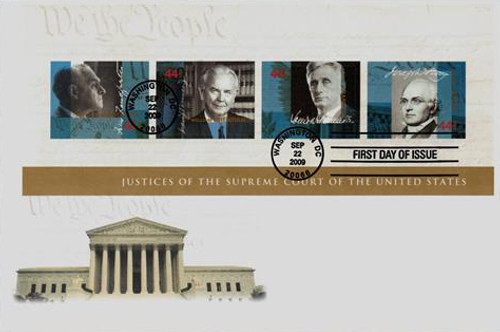
# 4422b - 2009 44c Supreme Court Justices: William Brennan
Supreme Court Justices
Issue Date: September 22, 2009
City: Washington, DC
In the spring of 1787, the Founding Fathers gathered in Philadelphia to write a new constitution. One hundred days later, tears streamed down Benjamin Franklin’s face as he put his name to the 4,400-word document that gave birth to the United States of America.
The U.S. Constitution is the shortest document of its kind and has several areas that are subject to interpretation. Questions of law regarding its meaning fall within the province of the Justices of the Supreme Court of the United States. Their historic decisions on civil liberties, industry, and the balance of interests between individuals and government touch the lives of Americans in countless ways every day.
A fierce defender of individual rights, William Brennan (1906-1997) was “probably the most influential justice of the century,” according to Justice Antonin Scalia. Appointed to the U.S. Supreme Court by Dwight Eisenhower in 1956, Brennan played a key role in shaping the direction of the Warren Court. (Earl Warren was Chief Justice from 1953-1969.) Their decisions resulted in sweeping advances in Civil Rights, equitable voter redistricting, and greater personal liberties.
Justice Brennan believed the Bill of Rights should be applied to state as well as federal government. With Brennan brokering agreements behind the scenes, the Warren Court began a string of rulings involving states. The Court found that Arkansas could not refuse to integrate public schools because the Court’s ruling on Brown v. Board of Education had a “binding effect” on the states. This was followed by the Court mandating states to create legislative districts that were roughly equal in population. Next, it ruled in Sherbert v. Verner that states could not interfere with a person’s free exercise of religion.
Justice William Brennan favored individual rights and placed the burden on the government to prove the Constitution disallowed protection. Brennan did not read the Constitution literally, but rather “as a 20th century American.”
Supreme Court Justices
Issue Date: September 22, 2009
City: Washington, DC
In the spring of 1787, the Founding Fathers gathered in Philadelphia to write a new constitution. One hundred days later, tears streamed down Benjamin Franklin’s face as he put his name to the 4,400-word document that gave birth to the United States of America.
The U.S. Constitution is the shortest document of its kind and has several areas that are subject to interpretation. Questions of law regarding its meaning fall within the province of the Justices of the Supreme Court of the United States. Their historic decisions on civil liberties, industry, and the balance of interests between individuals and government touch the lives of Americans in countless ways every day.
A fierce defender of individual rights, William Brennan (1906-1997) was “probably the most influential justice of the century,” according to Justice Antonin Scalia. Appointed to the U.S. Supreme Court by Dwight Eisenhower in 1956, Brennan played a key role in shaping the direction of the Warren Court. (Earl Warren was Chief Justice from 1953-1969.) Their decisions resulted in sweeping advances in Civil Rights, equitable voter redistricting, and greater personal liberties.
Justice Brennan believed the Bill of Rights should be applied to state as well as federal government. With Brennan brokering agreements behind the scenes, the Warren Court began a string of rulings involving states. The Court found that Arkansas could not refuse to integrate public schools because the Court’s ruling on Brown v. Board of Education had a “binding effect” on the states. This was followed by the Court mandating states to create legislative districts that were roughly equal in population. Next, it ruled in Sherbert v. Verner that states could not interfere with a person’s free exercise of religion.
Justice William Brennan favored individual rights and placed the burden on the government to prove the Constitution disallowed protection. Brennan did not read the Constitution literally, but rather “as a 20th century American.”









